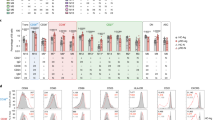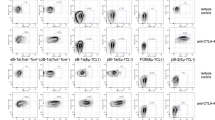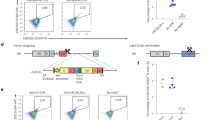Abstract
Self-reactive B cells specific for ubiquitous membrane-bound autoantigens are eliminated in the bone marrow by two mechanisms of tolerance: receptor editing and clonal deletion. However, the relative contributions of clonal deletion and receptor editing to B cell tolerance in a polyclonal B cell population have not been established. Here we show that tolerance toward a membrane antigen–reactive B cell clone acts by receptor editing with very minimal cell loss. The capacity of receptor editing to rescue almost all autoreactive B cells from deletion relies on the availability of multiple joining light chain gene segments as substrate for secondary immunoglobulin light chain gene rearrangement and is independent of the affinity of the autoantigen and the presence of non-autoreactive B cells. Our data further suggest that clonal deletion is a default pathway that functions only when receptor editing has been exhausted.
This is a preview of subscription content, access via your institution
Access options
Subscribe to this journal
Receive 12 print issues and online access
$209.00 per year
only $17.42 per issue
Buy this article
- Purchase on Springer Link
- Instant access to full article PDF
Prices may be subject to local taxes which are calculated during checkout





Similar content being viewed by others
References
Klinman, N.R. The “clonal selection hypothesis” and current concepts of B cell tolerance. Immunity 5, 189–195 (1996).
Rajewsky, K. Clonal selection and learning in the antibody system. Nature 381, 751–758 (1996).
Nossal, G.J. Cellular mechanisms of immunologic tolerance. Annu. Rev. Immunol. 1, 33–62 (1983).
Goodnow, C.C. et al. Self-tolerance checkpoints in B lymphocyte development. Adv. Immunol. 59, 279–368 (1995).
Nemazee, D. Receptor selection in B and T lymphocytes. Annu. Rev. Immunol. 18, 19–51 (2000).
Radic, M.Z. & Zouali, M. Receptor editing, immune diversification, and self-tolerance. Immunity 5, 505–511 (1996).
Moore, M.W., Durdik, J., Persiani, D.M. & Selsing, E. Deletions of κ chain constant region genes in mouse λ chain-producing B cells involve intrachromosomal DNA recombinations similar to V-J joining. Proc. Natl. Acad. Sci. USA 82, 6211–6215 (1985).
Persiani, D.M., Durdik, J. & Selsing, E. Active λ and κ antibody gene rearrangement in Abelson murine leukemia virus-transformed pre-B cell lines. J. Exp. Med. 165, 1655–1674 (1987).
Retter, M.W. & Nemazee, D. Receptor editing occurs frequently during normal B cell development. J. Exp. Med. 188, 1231–1238 (1998).
Tiegs, S.L., Russell, D.M. & Nemazee, D. Receptor editing in self-reactive bone marrow B cells. J. Exp. Med. 177, 1009–1020 (1993).
Gay, D., Saunders, T., Camper, S. & Weigert, M. Receptor editing: an approach by autoreactive B cells to escape tolerance. J. Exp. Med. 177, 999–1008 (1993).
Radic, M.Z., Erikson, J., Litwin, S. & Weigert, M. B lymphocytes may escape tolerance by revising their antigen receptors. J. Exp. Med. 177, 1165–1173 (1993).
Tze, L.E., Baness, E.A., Hippen, K.L. & Behrens, T.W. Ig light chain receptor editing in anergic B cells. J. Immunol. 165, 6796–6802 (2000).
Pelanda, R. et al. Receptor editing in a transgenic mouse model: site, efficiency, and role in B cell tolerance and antibody diversification. Immunity 7, 765–775 (1997).
Chen, C., Prak, E.L. & Weigert, M. Editing disease-associated autoantibodies. Immunity 6, 97–105 (1997).
Braun, U., Rajewsky, K. & Pelanda, R. Different sensitivity to receptor editing of B cells from mice hemizygous or homozygous for targeted Ig transgenes. Proc. Natl. Acad. Sci. USA 97, 7429–7434 (2000).
Kouskoff, V., Lacaud, G., Pape, K., Retter, M. & Nemazee, D. B cell receptor expression level determines the fate of developing B lymphocytes: receptor editing versus selection. Proc. Natl. Acad. Sci. USA 97, 7435–7439 (2000).
Li, H., Jiang, Y., Prak, E.L., Radic, M. & Weigert, M. Editors and editing of anti-DNA receptors. Immunity 15, 947–957 (2001).
Yachimovich, N., Mostoslavsky, G., Yarkoni, Y., Verbovetski, I. & Eilat, D. The efficiency of B cell receptor (BCR) editing is dependent on BCR light chain rearrangement status. Eur. J. Immunol. 32, 1164–1174 (2002).
Chen, C. et al. The site and stage of anti-DNA B-cell deletion. Nature 373, 252–255 (1995).
Casellas, R. et al. Contribution of receptor editing to the antibody repertoire. Science 291, 1541–1544 (2001).
Lang, J. et al. B cells are exquisitely sensitive to central tolerance and receptor editing induced by ultralow affinity, membrane-bound antigen. J. Exp. Med. 184, 1685–1697 (1996).
Nemazee, D.A. & Burki, K. Clonal deletion of B lymphocytes in a transgenic mouse bearing anti-MHC class I antibody genes. Nature 337, 562–566 (1989).
Hartley, S.B. et al. Elimination from peripheral lymphoid tissues of self-reactive B lymphocytes recognizing membrane-bound antigens. Nature 353, 765–769 (1991).
Spanopoulou, E. et al. Functional immunoglobulin transgenes guide ordered B-cell differentiation in Rag-1-deficient mice. Genes Dev. 8, 1030–1042 (1994).
Freitas, A.A., Rosado, M.M., Viale, A.C. & Grandien, A. The role of cellular competition in B cell survival and selection of B cell repertoires. Eur. J. Immunol. 25, 1729–1738 (1995).
Xu, H., Li, H., Suri-Payer, E., Hardy, R.R. & Weigert, M. Regulation of anti-DNA B cells in recombination-activating gene-deficient mice. J. Exp. Med. 188, 1247–1254 (1998).
Goodnow, C.C. Balancing immunity and tolerance: deleting and tuning lymphocyte repertoires. Proc. Natl. Acad. Sci. USA 93, 2264–2271 (1996).
Li, Y., Louzoun, Y. & Weigert, M. Editing anti-DNA B cells by Vλx. J. Exp. Med. 199, 337–346 (2004).
Arakawa, H., Shimizu, T. & Takeda, S. Re-evaluation of the probabilities for productive arrangements on the κ and λ loci. Int. Immunol. 8, 91–99 (1996).
Louzoun, Y., Friedman, T., Prak, E.L., Litwin, S. & Weigert, M. Analysis of B cell receptor production and rearrangement. Part I. Light chain rearrangement. Semin. Immunol. 14, 169–190 (2002).
Chen, C., Nagy, Z., Prak, E.L. & Weigert, M. Immunoglobulin heavy chain gene replacement: a mechanism of receptor editing. Immunity 3, 747–755 (1995).
Hartley, S.B. et al. Elimination of self-reactive B lymphocytes proceeds in two stages: arrested development and cell death. Cell 72, 325–335 (1993).
Yamagami, T., ten Boekel, E., Andersson, J., Rolink, A. & Melchers, F. Frequencies of multiple IgL chain gene rearrangements in single normal or κL chain-deficient B lineage cells. Immunity 11, 317–327 (1999).
Grandien, A., Fucs, R., Nobrega, A., Andersson, J. & Coutinho, A. Negative selection of multireactive B cell clones in normal adult mice. Eur. J. Immunol. 24, 1345–1352 (1994).
Wardemann, H. et al. Predominant autoantibody production by early human B cell precursors. Science 301, 1374–1377 (2003).
Pelanda, R., Schaal, S., Torres, R.M. & Rajewsky, K. A prematurely expressed Igκ transgene, but not VκJκ gene segment targeted into the Igκ locus, can rescue B cell development in λ5-deficient mice. Immunity 5, 229–239 (1996).
Coffman, R.L. Surface antigen expression and immunoglobulin gene rearrangement during mouse pre-B cell development. Immunol. Rev. 69, 5–23 (1982).
Grutzman, R. Vergleichende idiotypische analyse von receptoren mit spezifitat fur histokompatibilitatsantigene. Thesis, Univ. Cologne, Germany (1981).
Roes, J., Muller, W. & Rajewsky, K. Mouse anti-mouse IgD monoclonal antibodies generated in IgD-deficient mice. J. Immunol. Meth. 183, 231–237 (1995).
Coligan, J.E., Kruisbeek, A.M., Margulies, D.H., Shevach, E.M. & Strober, W. Current Protocols In Immunology (John Wiley & Sons, New York, 2000).
Acknowledgements
We thank K. Pape (University of Minnesota, Minneapolis, Minnesota) for the gift of anti-3-83κ and S. Liu for analyzing expression of CD19 in 3-83Igi, Rag1-deficient mice. We also thank P. Marrack for her constructive contributions during the writing of this manuscript; J. Cambier for critical reading of the manuscript; and F. Agenès (Institute Pasteur, Paris, France) for discussion that led to this work. This work was supported by the National Institutes of Health (AI052310 to R.P. and AI052157 to R.T.) and the Arthritis Foundation Colorado Chapter (R.P.).
Author information
Authors and Affiliations
Corresponding author
Ethics declarations
Competing interests
The authors declare no competing financial interests.
Supplementary information
Rights and permissions
About this article
Cite this article
Halverson, R., Torres, R. & Pelanda, R. Receptor editing is the main mechanism of B cell tolerance toward membrane antigens. Nat Immunol 5, 645–650 (2004). https://doi.org/10.1038/ni1076
Received:
Accepted:
Published:
Issue Date:
DOI: https://doi.org/10.1038/ni1076
This article is cited by
-
From risk to chronicity: evolution of autoreactive B cell and antibody responses in rheumatoid arthritis
Nature Reviews Rheumatology (2022)
-
B Cell Aberrance in Lupus: the Ringleader and the Solution
Clinical Reviews in Allergy & Immunology (2022)
-
B cell depletion therapies in autoimmune disease: advances and mechanistic insights
Nature Reviews Drug Discovery (2021)
-
Investigating the aetiology of adverse events following HPV vaccination with systems vaccinology
Cellular and Molecular Life Sciences (2019)
-
Mechanisms of central tolerance for B cells
Nature Reviews Immunology (2017)



